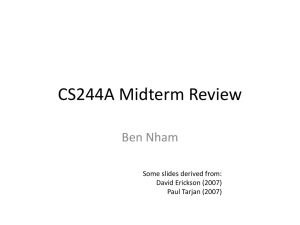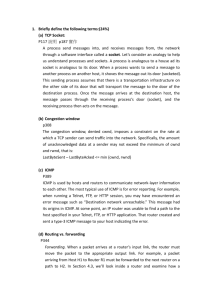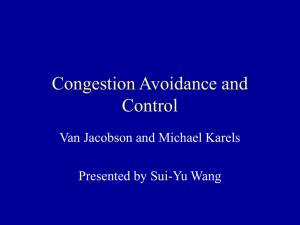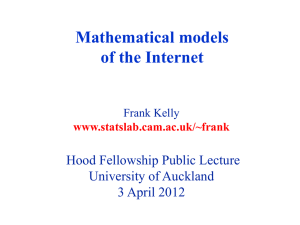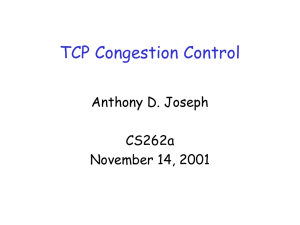CS 356: Computer Network Architectures Lecture 17: Network Resource Allocation Chapter 6.1-6.4
advertisement
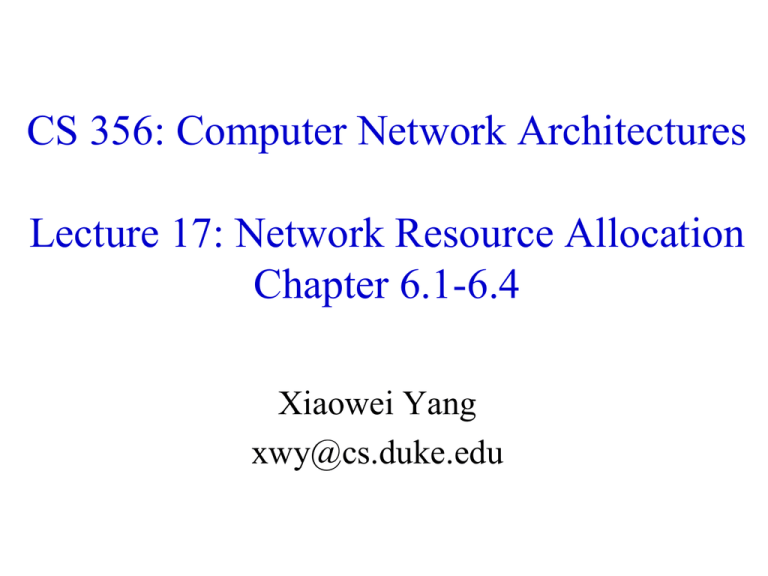
CS 356: Computer Network Architectures Lecture 17: Network Resource Allocation Chapter 6.1-6.4 Xiaowei Yang xwy@cs.duke.edu Overview • TCP congestion control • The problem of network resource allocation – Case studies • TCP congestion control • Fair queuing • Congestion avoidance – Case studies • Router + Host – DECbit, Active queue management • Source-based congestion avoidance Two Modes of Congestion Control 1. Probing for the available bandwidth – slow start (cwnd < ssthresh) 2. Avoid overloading the network – congestion avoidance (cwnd >= ssthresh) Slow Start • Initial value: Set cwnd = 1 MSS • Modern TCP implementation may set initial cwnd to 2 • When receiving an ACK, cwnd+= 1 MSS • If an ACK acknowledges two segments, cwnd is still increased by only 1 segment. • Even if ACK acknowledges a segment that is smaller than MSS bytes long, cwnd is increased by 1. • Question: how can you accelerate your TCP download? Congestion Avoidance • If cwnd >= ssthresh then each time an ACK is received, increment cwnd as follows: • cwnd += MSS * (MSS / cwnd) (cwnd/MSS is the number of maximum sized segments within one cwnd) • So cwnd is increased by one MSS only if all cwnd/MSS segments have been acknowledged. Example of Slow Start/Congestion Avoidance Assume ssthresh = 8 MSS cwnd = 1 cwnd = 2 cwnd = 4 14 Cwnd (in segments) 12 cwnd = 8 10 ssthresh 8 6 4 cwnd = 9 2 0 t= 0 2 t= t= 4 Roundtrip times 6 t= cwnd = 10 Congestion detection • What would happen if a sender keeps increasing cwnd? – Packet loss • TCP uses packet loss as a congestion signal • Loss detection 1. Receipt of a duplicate ACK (cumulative ACK) 2. Timeout of a retransmission timer Reaction to Congestion • Reduce cwnd • Timeout: severe congestion – cwnd is reset to one MSS: cwnd = 1 MSS – ssthresh is set to half of the current size of the congestion window: ssthressh = cwnd / 2 – entering slow-start Reaction to Congestion • Duplicate ACKs: not so congested (why?) • Fast retransmit – Three duplicate ACKs indicate a packet loss – Retransmit without timeout Duplicate ACK example 1K SeqNo=0 AckNo=1024 1K SeqNo=1 024 1K SeqNo=2 048 1. duplicate AckNo=1024 1K SeqNo=3 072 2. duplicate AckNo=1024 1K SeqNo=4 096 3. duplicate AckNo=1024 1K SeqNo=1 024 1K SeqNo=5 120 10 Reaction to congestion: Fast Recovery • Avoiding slow start – ssthresh = cwnd/2 – cwnd = cwnd+3MSS – Increase cwnd by one MSS for each additional duplicate ACK • When ACK arrives that acknowledges “new data,” set: cwnd=ssthresh enter congestion avoidance Flavors of TCP Congestion Control • TCP Tahoe (1988, FreeBSD 4.3 Tahoe) – Slow Start – Congestion Avoidance – Fast Retransmit • TCP Reno (1990, FreeBSD 4.3 Reno) – Fast Recovery – Modern TCP implementation • New Reno (1996) • SACK (1996) TCP Tahoe TCP Reno TCP saw tooth SS CA Fast retransmission/fast recovery Overview • TCP congestion control • The problem of network resource allocation – Case studies • TCP congestion control • Fair queuing • Congestion avoidance – Case studies • Router + Host – DECbit, Active queue management • Source-based congestion avoidance Network resource allocation ... • Packet switching • Statistical multiplexing • Q: N users, and one bottleneck – How fast should each user send? – A difficult problem • Each user/router does not know N • Each user does not know the bottleneck capacity Goals • Efficient: do not waste bandwidth – Work-conserving • Fairness: do not discriminate users – What is fair? (later) Two high-level approaches • End-to-end congestion control – End systems voluntarily adjust sending rates to achieve fairness and efficiency – Good for old days – Problematic today • Why? • Router-enforced – Fair queuing End-to-end congestion control Model – A feedback control system – The network uses feedback y to adjust users’ load x_i Goals • Efficiency: the closeness of the total load on the resource to its knee • Fairness: – When all xi’s are equal, F(x) = 1 – When all xi’s are zero but xj = 1, F(x) = 1/n • Distributed • Convergence Metrics to measure convergence • Responsiveness • Smoothness Model the system as a linear control system • Four sample types of controls • AIAD, AIMD, MIAD, MIMD • Questions: what type of control does TCP use? TCP congestion control revisited Cwnd RTT • For every ACK received – Cwnd += 1/cwnd • For every packet loss – Cwnd /= 2 Does AIMD achieve fairness and efficiency? x 2 Phase plot x1 End-to-end congestion Control Challenges Cwnd Cwnd/2 RTT • Each source has to probe for its bandwidth • Congestion occurs first before TCP backs off • Unfair – Long RTT flows obtain smaller bandwidth shares – Malicious hosts, UDP applications Macroscopic behavior of TCP • Throughput is inversely proportional to RTT, and 1.5 MSS RTT p • In a steady state, total packets sent in one sawtooth cycle: – S = w/2 + (w/2+1) + … (w/2+w/2) = 3/8 w2 • the maximum window size is determined by the loss rate – p = 1/S – w = sqrt(1/(3/8p)) • The length of one cycle: w/2*RTT • Average throughput: 3/4 w * MSS / RTT Router-enforced Resource Allocation Router Mechanisms • Queuing – Scheduling: which packets get transmitted – Promptness: when do packets get transmitted – Buffer: which packets are discarded • Ex: FIFO + DropTail – Most widely used Fair queuing • Using multiple queues to ensure fairness • Challenges – Fair to whom? • Source, Receiver, Process • Flow / conversation: Src and Dst pair – Flow is considered the best tradeoff – What is fair? • Maximize fairness index? – Fairness = (Sxi)2/n(Sxi2) 0<fairness<1 • What if a flow uses a long path? • Tricky, no satisfactory solution, policy vs. mechanism One definition: Max-min fairness • Many fair queuing algorithms aim to achieve this definition of fairness • Informally – • Allocate user with “small” demand what it wants, evenly divide unused resources to “big” users Formally 1. 2. No user receives more than its request No other allocation satisfies 1 and has a higher minimum allocation • 3. Users that have higher requests and share the same bottleneck link have equal shares Remove the minimal user and reduce the total resource accordingly, 2 recursively holds Max-min example 1. Increase all flows’ rates equally, until some users’ requests are satisfied or some links are saturated 2. Remove those users and reduce the resources and repeat step 1 – – Assume sources 1..n, with resource demands X1..Xn in ascending order Assume channel capacity C. • Give C/n to X1; if this is more than X1 wants, divide excess (C/n - X1) to other sources: each gets C/n + (C/n - X1)/(n-1) • If this is larger than what X2 wants, repeat process Design of fair queuing • Goals: – Max-min fair – Work conserving: link’s not idle if there is work to do – Isolate misbehaving sources – Has some control over promptness • E.g., lower delay for sources using less than their full share of bandwidth • Continuity A simple fair queuing algorithm • Nagle’s proposal: separate queues for packets from each individual source • Different queues are serviced in a round-robin manner • Limitations – Is it fair? – What if a short packet arrives right after one departs? Implementing max-min Fairness • Generalized processor sharing – Fluid fairness – Bitwise round robin among all queues • Weighted Fair Queuing: – Emulate this reference system in a packetized system – Challenges: bits are bundled into packets. Simple round robin scheduling does not emulate bit- by-bit round robin Emulating Bit-by-Bit round robin • Define a virtual clock: the round number R(t) as the number of rounds made in a bit-by-bit roundrobin service discipline up to time t • A packet with size P whose first bit serviced at round R(t0) will finish at round: – R(t) = R(t0) + P • Schedule which packet gets serviced based on the finish round number Example F=7 F=6 F = 10 F=3 Compute finish times • Arrival time of packet i from a flow: ti • Packet size: Pi • Si be the round number when the packet starts service • Fi be the finish round number • Fi = Si + Pi • Si = Max (Fi-1, R(ti)) Compute R(ti) can be complicated • Single flow: clock ticks when a bit is transmitted. For packet i: – Round number R(ti) ≈ Arrival time Ai – Fi = Si+Pi = max (Fi-1, Ai) + Pi • Multiple flows: clock ticks when a bit from all active flows is transmitted – When the number of active flows vary, clock ticks at different speed: R/ t = linkSpeed/Nac(t) An example P=5 t=0 t=4 P=6 t=12 P=2 t=6 R(t) P=3 P=4 t=1 0 • Two flows, unit link speed 1 • Q: how to compute the (virtual) finish time of each packet? t Delay Allocation • Reduce delay for flows using less than fair share – Advance finish times for sources whose queues drain temporarily • Schedule based on Bi instead of Fi – Fi = Pi + max (Fi-1, Ai) Bi = Pi + max (Fi-1, Ai - d) – If Ai < Fi-1, conversation is active and d has no effect – If Ai > Fi-1, conversation is inactive and d determines how much history to take into account • Infrequent senders do better when history is used – When d = 0, no effect – When d = infinity, an infrequent sender preempts other senders Properties of Fair Queuing • Work conserving • Each flow gets 1/n Weighted Fair Queuing w=1 w=2 • Different queues get different weights – Take wi amount of bits from a queue in each round – Fi = Si+Pi / wi • Quality of service Deficit Round Robin (DRR) • WFQ: extracting min is O(log Q) • DRR: O(1) rather than O(log Q) – Each queue is allowed to send Q bytes per round – If Q bytes are not sent (because packet is too large) deficit counter of queue keeps track of unused portion – If queue is empty, deficit counter is reset to 0 – Similar behavior as FQ but computationally simpler • Unused quantum saved for the next round • How to set quantum size? – Too small – Too large Review of Design Space • Router-based vs. Host-based • Reservation-based vs. Feedback-based • Window-based vs. Rate-based Overview • The problem of network resource allocation – Case studies • TCP congestion control • Fair queuing • Congestion avoidance – Active queue management – Source-based congestion avoidance Congestion Avoidance Design goals • Predict when congestion is going to happen • Reduce sending rate before buffer overflows • Not widely deployed – Reducing queuing delay and packet loss are not essential Mechanisms • Router+host joint control – Router: Early signaling of congestion – Host: react to congestion signals – Case studies: DECbit, Random Early Detection • Host: Source-based congestion avoidance – Host detects early congestion – Case study: TCP Vegas DECbit • Add a congestion bit to a packet header • A router sets the bit if its average queue length is non-zero – Queue length is measured over a busy+idle interval • If less than 50% of packets in one window do not have the bit set – A host increases its congest window by 1 packet • Otherwise – Decreases by 0.875 • AIMD Random Early Detection • Random early detection (Floyd93) – Goal: operate at the “knee” – Problem: very hard to tune (why) • RED is generalized by Active Queue Managment (AQM) • A router measures average queue length using exponential weighted averaging algorithm: – AvgLen = (1-Weight) * AvgLen + Weight * SampleQueueLen RED algorithm p 1 min_thresh max_thresh • If AvgLen ≤ MinThreshold – Enqueue packet • If MinThreshold < AvgLen < MaxThreshold – Calculate dropping probability P – Drop the arriving packet with probability P • If MaxThreshold ≤ AvgLen – Drop the arriving packet avg_qlen Even out packet drops TempP 1 min_thresh max_thresh avg_qlen • TempP = MaxP x (AvgLen – Min)/(Max-Min) • P = TempP / (1 – count * TempP) • Count keeps track of how many newly arriving packets have been queued when min < Avglen < max • It keeps drop evenly distributed over time, even if packets arrive in burst An example • • • • • MaxP = 0.02 AvgLen is half way between min and max thresholds TempP = 0.01 A burst of 1000 packets arrive With TempP, 10 packets may be discarded uniformly randomly among the 1000 packets • With P, they are likely to be more evently spaced out, as P gradually increases if previous packets are not discarded Explicit Congestion Notification • A new IETF standard • We use two bits in IP header (ECN bits) for routers to signal congestion back to TCP senders • TCP halves its window size as if it suffers a packet drop • Use a Congestion Experience (CE) bit to signal congestion, instead of a packet drop CE=1 X ECE=1 – Why is it better than a drop? CWR=1 • AQM is used for packet marking Source-based congestion avoidance • TCP Vegas – Detect increases in queuing delay – Reduces sending rate • Details – – – – Record baseRTT (minimum seen) Compute ExpectedRate = cwnd/BaseRTT Diff = ExpectedRate - ActualRate When Diff < α, incr cwnd linearly, when Diff > β, decr cwnd linearly • α< β cwnd Summary • The problem of network resource allocation – Case studies • TCP congestion control • Fair queuing • Congestion avoidance – Active queue management – Source-based congestion avoidance
